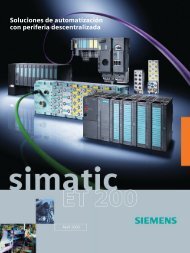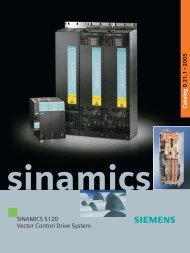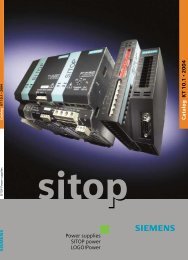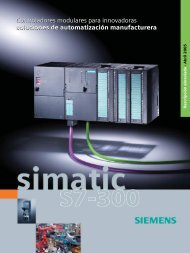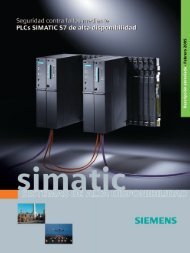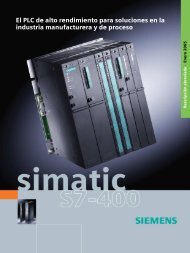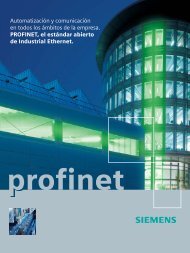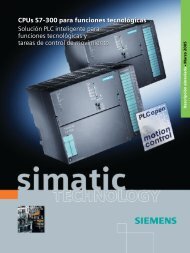SIMATIC PCS 7 process control system
SIMATIC PCS 7 process control system
SIMATIC PCS 7 process control system
You also want an ePaper? Increase the reach of your titles
YUMPU automatically turns print PDFs into web optimized ePapers that Google loves.
This makes it possible to divide a plant into technological units<br />
and to distribute the data accordingly to several OS servers/<br />
pairs of servers. In addition to scalability, the advantage of distributed<br />
<strong>system</strong>s is the ability to decouple plant areas from<br />
each other, which results in higher availability.<br />
<strong>SIMATIC</strong> <strong>PCS</strong> 7 supports multi-user <strong>system</strong>s with up to<br />
12 servers or 12 redundant pairs of servers. In multi-client<br />
mode, OS clients can access data from one or more of the<br />
12 OS servers/pairs of servers in parallel (up to 32 OS clients<br />
simultaneously on all).<br />
The OS servers are designed in addition with client functions<br />
which permit them to access the data (archives, messages,<br />
tags, variables) from the other OS servers of the multi-user<br />
<strong>system</strong>. This means that <strong>process</strong> graphics on one OS server<br />
can also be linked with variables on other OS servers (areaindependent<br />
displays).<br />
Like the OS single stations, the OS servers can be connected to<br />
the Industrial Ethernet plant bus using a communications <strong>process</strong>or<br />
or a standard LAN card. A FastEthernet RJ45 port is already<br />
on board and can be used for connecting to an OS LAN<br />
(terminal bus).<br />
Central<br />
Archive Server<br />
Automation <strong>system</strong>s<br />
Multi-user <strong>system</strong> with client/server architecture<br />
OS clients<br />
(max. 32 in<br />
multi-client mode)<br />
OS servers<br />
(max. 12<br />
redundant)<br />
Performance and technical specifications<br />
The <strong>SIMATIC</strong> <strong>PCS</strong> 7 operator <strong>system</strong> is optimized for <strong>process</strong>ing<br />
large quantities of data. It has an impressively high performance<br />
– even with large quantity frameworks – and can be<br />
operated simply and intuitively at the same time.<br />
Many individual measures reduce the <strong>system</strong> load and improve<br />
the image selection and updating times, e.g.:<br />
■ Combination of status and analog values with alarm information<br />
into expanded status displays<br />
■ Suppression of nuisance alarms and triggering of renewed<br />
transmission via acknowledgment<br />
■ Data transmission from the automation <strong>system</strong> only following<br />
changes instead of with every cycle<br />
■ Blocking/enabling of messages for individual <strong>process</strong> tags<br />
or all tags of an area<br />
Operator <strong>system</strong><br />
Max. number of OS servers/pairs of 12<br />
servers<br />
Max. number of automation <strong>system</strong>s<br />
per OS server/pair of servers<br />
64<br />
Max. number of OS clients in multiclient<br />
mode 1) (per multi-user sys-<br />
32<br />
tem)<br />
Max. number of monitors per operator<br />
station with multi-channel op-<br />
4<br />
eration<br />
Max. number of OS areas 64<br />
Max. number of windows per 1 to 16 (adjustable)<br />
monitor<br />
Number of trends per<br />
10<br />
trend window<br />
Selection time for OS area display < 2 s<br />
(100 <strong>process</strong> symbols)<br />
Max. number of variables/<strong>process</strong><br />
objects:<br />
• Per OS single station<br />
150K / 5,000 POs<br />
• Per OS server<br />
256K / 8,500 POs<br />
Max. number of configurable messages<br />
per server<br />
50,000<br />
Number of <strong>process</strong> tags<br />
• Per OS single station Approx. 3,000<br />
• Per OS server Approx. 5,000<br />
• Per multi-user <strong>system</strong> Approx. 60,000<br />
Integral high-performance archive<br />
<strong>system</strong> (cyclic buffer), based on<br />
Microsoft SQL server, for:<br />
• Process value archiving<br />
Approx. 1,000/s<br />
(per OS server/single station)<br />
• Message archiving<br />
(per OS server/single station)<br />
Long-term archiving<br />
• Process value archiving with<br />
StoragePlus (<strong>process</strong> values<br />
from up to 4 single stations,<br />
servers or pairs of servers)<br />
• Process value archiving with<br />
central archive server CAS (<strong>process</strong><br />
values from up to 11 servers<br />
or pairs of servers)<br />
Continuous load approx. 10/s<br />
Rush of alarms approx.<br />
3,000 / 4 s<br />
Process values of one server:<br />
approx. 1,000/s<br />
Process values of all servers:<br />
approx. 1,600/s<br />
Process values of one server:<br />
approx. 1,000/s<br />
Process values of all servers:<br />
approx. 10,000/s<br />
1) If every OS client has access to all OS servers/pairs of servers<br />
Operator <strong>system</strong> 21




